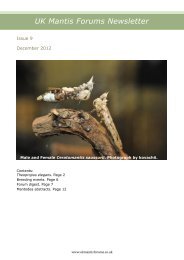UK mantis forums newsletter
UK mantis forums newsletter
UK mantis forums newsletter
Create successful ePaper yourself
Turn your PDF publications into a flip-book with our unique Google optimized e-Paper software.
<strong>UK</strong>MF Newsletter issue 6<br />
Average feeding success in nature appears to be relatively high, when comparing the rate of<br />
abdominal expansion in the field to captive females maintained on High diets. 6. In the field,<br />
nearly all mounts and copulations occurred in September in both years, when female feeding<br />
success is expected to be high. If mating activity occurs during a window of high female<br />
feeding success, so as to reduce the risk of cannibalism for males, then the female feeding<br />
regime may be implicated in the phenology of mating activity in cannibalistic species.<br />
Mohammad, K. S., Alla, S. M. G., El-Hamouly, H., Ehrmann, R., Nasser, M. G. E.,<br />
Mantodea of Egypt. Zootaxa, 2011, 3044: 1–27.<br />
Abstract: The Mantodea of Egypt were studied by examining and identifying specimens<br />
from four main Egyptian collections and some of those preserved in international museums,<br />
collecting specimens from various parts of the country between July 2007 and April 2010,<br />
and previous Egyptian records. We found 60 species belonging to 21 genera and 4 families.<br />
Eremiaphilidae included 31 species in 2 genera with one new record from Egypt,<br />
Eremiaphila gigas; Empusidae, 7 species in 4 genera; Mantidae, 18 species in 13 genera<br />
with one new species, Elaea solimani; and Tarachodidae, 3 species in 2 genera. We provide<br />
identification keys for Egyptian taxa, data on the material examined, the world distribution,<br />
synonyms and a description of the new species.<br />
O’Hanlon, J., Intraspecific Interactions and Their Effect on Habitat Utilisation by the<br />
Praying Mantid Ciulfina biseriata (Mantodea: Liturgusidae). Journal of Ethology 2011,<br />
29 (1): 47-54. Url: http://dx.doi.org/10.1007/s10164-010-0220-6<br />
Abstract: Tree trunks are spatially separated habitat patches for the tree-running mantid<br />
Ciulfina biseriata (Mantodea: Liturgusidae). This paper investigates how intraspecific<br />
interactions may affect spacing patterns in C. biseriata. Many mantid species inhabit tree<br />
trunk surfaces, but little is known about how they interact with this type of habitat.<br />
Behavioural observations and choice tests investigated the effect of a conspecific on habitat<br />
utilisation. Field surveys were used to investigate patterns of movement in the field. The<br />
decision to inhabit a tree trunk may be affected by the presence of a conspecific. Whereas<br />
adult males seek out females when selecting habitat, females will actively avoid males.<br />
Habitat choice decisions are primarily based on aspects of their mating system rather than<br />
on competition for space or food resources. The behavioural interactions of C. biseriata are<br />
described, including novel observations of same-sex mating behaviour in adult males.<br />
O’Hanlon, J. C. and Holwell, G. I., The Influence of Abrupt Forest Edges on Praying<br />
Mantid Populations. Insect Conservation and Diversity, 2011, 4 (2): 107–114.<br />
Abstract: 1. The concept of an 'edge' habitat that is influenced by the biotic and abiotic<br />
characteristics of neighbouring habitats is a broadly applied principle in ecology. 2. Ciulfina<br />
klassi Giglio-Tos (Mantodea: Liturgusidae) inhabit vertical tree trunk surfaces in a restricted<br />
patch of coastal Melaleuca woodlands in the world heritage listed Wet Tropics Region of far<br />
north Queensland, Australia. Preliminary observations suggested that abrupt forest edges<br />
may have a positive effect on population density in the praying <strong>mantis</strong> C. klassi. 3. During<br />
field surveys over a two-year period, mantid densities were found to be higher at forest<br />
edges than forest interiors. 4. Greater sapling recruitment at forest edges may contribute to<br />
this edge effect by providing dense patches of tree trunk habitats. 5. The population<br />
characteristics of C. klassi are also described here in the context of our current<br />
understanding of praying mantid life histories. Aspects of the ecology of this tropical praying<br />
29<br />
www.uk<strong>mantis</strong><strong>forums</strong>.co.uk




